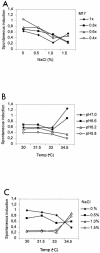Effects of diverse environmental conditions on {phi}LC3 prophage stability in Lactococcus lactis
- PMID: 15691922
- PMCID: PMC546743
- DOI: 10.1128/AEM.71.2.721-727.2005
Effects of diverse environmental conditions on {phi}LC3 prophage stability in Lactococcus lactis
Abstract
The effects of various growth conditions on spontaneous phiLC3 prophage induction in Lactococcus lactis subsp. cremoris IMN-C1814 was analyzed with a half fraction of a 4(4) factorial experimental design. The four factors included in the study were nutrient availability, acidity, osmolarity, and temperature, each applied at four levels. These environmental factors are related to the fermentation processes in the dairy industry, in which bacteriophage attacks on sensitive starter strains are a constant threat to successful fermentation processes. The frequency of spontaneous phiLC3 induction was determined by quantitative analyses of restored DNA attachment sites (attB) on the bacterial chromosomes in a population of lysogenic cells. Statistical analysis revealed that all four environmental factors tested affected phiLC3 prophage stability and that the environmental factors were involved in interactions (interactions exist when the effect of one factor depends on the level of another factor). The spontaneous phiLC3 induction frequency varied from 0.08 to 1.76%. In general, the induction frequency remained at the same rate or decreased when level 1 to 3 of the four environmental factors was applied. At level 4, which generally gave the least favorable growth conditions, the induction frequency was either unchanged, decreased, or increased, depending on the type of stress. It appeared that the spontaneous induction frequency was independent of the growth behavior of the host. It was the environmental growth conditions that were the decisive factor in induction frequency.
Figures



Similar articles
-
Use of real-time quantitative PCR for the analysis of phiLC3 prophage stability in lactococci.Appl Environ Microbiol. 2003 Jan;69(1):41-8. doi: 10.1128/AEM.69.1.41-48.2003. Appl Environ Microbiol. 2003. PMID: 12513975 Free PMC article.
-
Stability of active prophages in industrial Lactococcus lactis strains in the presence of heat, acid, osmotic, oxidative and antibiotic stressors.Int J Food Microbiol. 2016 Mar 2;220:26-32. doi: 10.1016/j.ijfoodmicro.2015.12.012. Epub 2015 Dec 30. Int J Food Microbiol. 2016. PMID: 26773254
-
Spontaneously induced prophages are abundant in a naturally evolved bacterial starter culture and deliver competitive advantage to the host.BMC Microbiol. 2018 Sep 24;18(1):120. doi: 10.1186/s12866-018-1229-1. BMC Microbiol. 2018. PMID: 30249194 Free PMC article.
-
Resident TP712 Prophage of Lactococcus lactis Strain MG1363 Provides Extra Holin Functions to the P335 Phage CAP for Effective Host Lysis.Appl Environ Microbiol. 2021 Sep 10;87(19):e0109221. doi: 10.1128/AEM.01092-21. Epub 2021 Sep 10. Appl Environ Microbiol. 2021. PMID: 34260308 Free PMC article.
-
Prophage induction in Lactococcus lactis by the bacteriocin Lactococcin 972.Int J Food Microbiol. 2009 Jan 31;129(1):99-102. doi: 10.1016/j.ijfoodmicro.2008.11.004. Epub 2008 Nov 14. Int J Food Microbiol. 2009. PMID: 19056139
Cited by
-
Bacteriophages of lactic acid bacteria and their impact on milk fermentations.Microb Cell Fact. 2011 Aug 30;10 Suppl 1(Suppl 1):S20. doi: 10.1186/1475-2859-10-S1-S20. Epub 2011 Aug 30. Microb Cell Fact. 2011. PMID: 21995802 Free PMC article. Review.
-
A composite bacteriophage alters colonization by an intestinal commensal bacterium.Proc Natl Acad Sci U S A. 2012 Oct 23;109(43):17621-6. doi: 10.1073/pnas.1206136109. Epub 2012 Oct 8. Proc Natl Acad Sci U S A. 2012. PMID: 23045666 Free PMC article.
-
When Plaquing Is Not Possible: Computational Methods for Detecting Induced Phages.Viruses. 2023 Feb 2;15(2):420. doi: 10.3390/v15020420. Viruses. 2023. PMID: 36851634 Free PMC article.
-
Impact of spontaneous prophage induction on the fitness of bacterial populations and host-microbe interactions.J Bacteriol. 2015 Feb;197(3):410-9. doi: 10.1128/JB.02230-14. Epub 2014 Nov 17. J Bacteriol. 2015. PMID: 25404701 Free PMC article. Review.
-
Lysogenic bacteriophages encoding arsenic resistance determinants promote bacterial community adaptation to arsenic toxicity.ISME J. 2023 Jul;17(7):1104-1115. doi: 10.1038/s41396-023-01425-w. Epub 2023 May 9. ISME J. 2023. PMID: 37161002 Free PMC article.
References
-
- Bissonnette, F., S. Labrie, H. Deveau, M. Lamoureux, and S. Moineau. 2000. Characterization of mesophilic mixed starter cultures used for the manufacture of aged cheddar cheese. J. Dairy Sci. 83:620-627. - PubMed
-
- Blatny, J. M., L. Godager, M. Lunde, and I. F. Nes. 2004. Complete genome sequence of the Lactococcus lactis temperate phage φLC3: comparative analysis of φLC3 and its relatives in lactococci and streptococci. Virology 318:231-244. - PubMed
-
- Blatny, J. M., P. A. Risoen, D. Lillehaug, M. Lunde, and I. F. Nes. 2001. Analysis of a regulator involved in the genetic switch between lysis and lysogeny of the temperate Lactococcus lactis phage φLC3. Mol. Genet. Genomics 265:189-197. - PubMed
-
- Blatny, J. M., M. Ventura, E. M. Rosenhaven, P. A. Risoen, M. Lunde, H. Brussow, and I. F. Nes. 2003. Transcriptional analysis of the genetic elements involved in the lysogeny/lysis switch in the temperate lactococcal bacteriophage φLC3, and identification of the Cro-like protein ORF76. Mol. Genet. Genomics 269:487-498. - PubMed
-
- Bouchard, J. D., and S. Moineau. 2000. Homologous recombination between a lactococcal bacteriophage and the chromosome of its host strain. Virology 270:65-75. - PubMed
Publication types
MeSH terms
Substances
LinkOut - more resources
Full Text Sources

